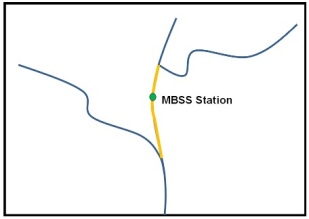Per the Antidegradation Policy implementation Procedures, Tier II stream segments can be designated based on a numeric water quality value or based on the biological water quality condition. So far, Tier II waters have only been designated on the basis of biological condition data collected using Maryland Biological Stream Survey (MBSS) protocols.
To identify Tier II streams, MDE compiles readily available MBSS data that meet the Biological Data Quality Guidelines which can be used to designate and/or assess Tier II waters. In order to designate a new Tier II stream, MDE must identify data meeting the biological water quality condition threshold and delineate the appropriate Tier II stream segment.
1. Identify data meeting the biological water quality condition threshold
The Code of Maryland Regulations (COMAR) 26.08.02.04-1(D)3b states that MBSS data must show that stream “water quality is within 20 percent of the maximum attainable value of the index of biological integrity” (IBI). MBSS calculates IBIs for both benthic macroinvertebrates, e.g. bugs, and fish data, on a scale of 1.00-5.00. On a given stream segment, both independent IBI scores (macroinvertebrates and fish) must be 4.00 or greater to be designated as Tier II high quality.
Sometimes, multiple stations are on one stream segment. When this occurs, the IBI scores from each station are averaged. If the mean of the benthic IBI scores, and the mean of their fish IBI scores are still greater than or equal to 4.00, then that segment is designated as Tier II. In this case, a single sample result below 4.00 does not disqualify that segment from being designated as Tier II. As long as the overall mean of the BIBI scores and the FIBI scores, calculated independently, are greater than or equal to 4.00 that segment will be given the Tier II designation.
Some stream segments contain data from annual monitoring going back as far as 1995. Occasionally, one of those stations may have uncharacteristically low IBI scores, perhaps due to extreme drought conditions. In this case, MDE uses best professional judgment to remove these particular sampling events from the Tier II determination analysis. To help make this decision, MDE uses an outlier analysis to determine if the scores for that year are truly outside the normal range of a site’s variability.
2. Delineate the appropriate Tier II stream segment.
 Tier II stream designations follow the confluence-to-confluence stream segment identification method. This means that a designated stream segment cannot extend beyond the point where it meets another stream. The orange line in the diagram to the right illustrates the Tier II segment corresponding to the monitoring station represented by a green dot. Also of note, Tier II stream segment endpoints do not cross the boundary of lakes or reservoirs.
Tier II stream designations follow the confluence-to-confluence stream segment identification method. This means that a designated stream segment cannot extend beyond the point where it meets another stream. The orange line in the diagram to the right illustrates the Tier II segment corresponding to the monitoring station represented by a green dot. Also of note, Tier II stream segment endpoints do not cross the boundary of lakes or reservoirs.
Click here to return to the Maryland Tier II Waters homepage.
Contact Information:
Please direct any questions or comments concerning Maryland's Antidegradation program to Angel Valdez at [email protected].
This page was last updated 06/2021.